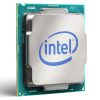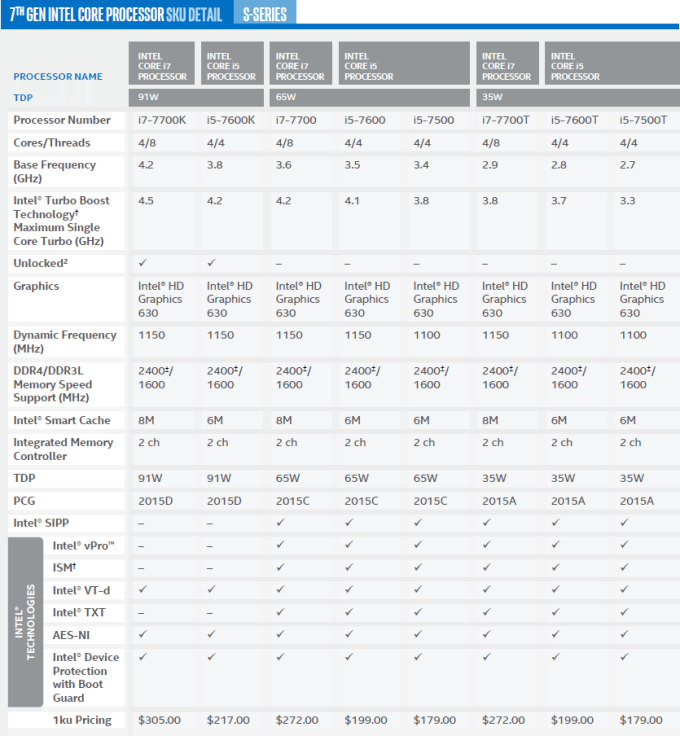- Qualcomm Launches Snapdragon 4 Gen 2 Mobile Platform
- AMD Launches Ryzen PRO 7000 Series Mobile & Desktop Platform
- Intel Launches Sleek Single-Slot Arc Pro A60 Workstation Graphics Card
- NVIDIA Announces Latest Ada Lovelace Additions: GeForce RTX 4060 Ti & RTX 4060
- Maxon Redshift With AMD Radeon GPU Rendering Support Now Available
Intel Kaby Lake Core i7-7700K Performance & Z270 Chipset Overview

Intel’s latest 7th generation CPUs were launched a couple months back with a focus on the mobile markets. Today, Kaby Lake finally comes to the desktop with eager hands awaiting. A new platform is introduced with the Z270 chipset, new overclocking features, Optane Memory, and an unlocked i3 CPU. Read on as we put the flagship Core i7-7700K under review!
Page 4 – i7-7700K Performance Benchmarks – Gaming, Sub-System & Final Thoughts
Gaming Performance
A CPU’s weighting on game related performance is often negligible for modern titles. For the most part, the CPU’s single-threaded performance is the biggest factor. Modern titles are finally beginning to take advantage of more threads and advanced instruction sets, as seen with the likes of Battlefield 1, but in general, clock speed is the deciding factor.
| 3D Mark Fire Strike | ||
| 1080p | i7-6700K | i7-7700k |
| Overall | 11306 | 11397 |
| Graphics | 13334 | 13335 |
| Physics | 13556 | 14446 |
| 1440p | ||
| Overall | 5981 | 5938 |
| Graphics | 6246 | 6234 |
| Physics | 13415 | 14329 |
| 4K | ||
| Overall | 3036 | 3061 |
| Graphics | 2952 | 2975 |
| Physics | 13429 | 14328 |
| 3DMark results in points; higher is better. | ||
While Intel focuses on 3D Mark’s lower end tests like Sky Dive, realistically speaking, that provides little relevance to modern games (the benchmark is getting on a bit now). If we were testing the IGP for something like a Laptop, then we might include it, but we’ve got an overclockable premium CPU here with dedicated graphics – no IGP here.
As such, the results are mostly predictable. Graphical performance differences are negligible, but physics tests come out ahead with the 7700K – which is expected when there’s an extra 300MHz on the turbo, and 200MHz on the base clock.
| Unigine Heaven 4.0 | ||
| Min FPS | Avg FPS | |
| Intel Core i7-7700K | 35.3 | 88.9 |
| Intel Core i7-6700K | 8.9 | 88.3 |
| Settings: Ultra-tex, 4xAA, Normal-tess Results in Frames Per Second; higher is better. |
||
The same is seen again with Unigine Heaven. Don’t pay too much attention to the min FPS of the 6700K as that is just a hiccup that can occur with scoring, as it measures the lowest FPS, rather than a more typical average of the 1% lowest FPS.
Sub-system Performance
With the system specific tests completed, we’ll delve into the sub-system performance with SANDRA. These tests are long and arduous with huge amounts of granularity to them, providing a better understanding of the types of workload the chips are best suited to.
| SiSoftware SANDRA 2016 SP3 | |||
| i7-6700K | i7-7700K | ||
| Arithmetic | 123.76 GOPS | 132.63 GOPS | |
| Multi-Media | 420.39 MPix/s | 453.81 MPix/s | |
| Cryptography High Security | 8.72 GB/s | 9 GB/s | |
| Financial Analysis | 24.0 kOPT/s | 25.63 kOPT/s | |
| Scientific Analysis | 24.2 GFLOPS | 25 GFLOPS | |
| Memory Bandwidth | 26.00 GB/s | 26.33 GB/s | |
| Cache & Memory Latency* | 24.1 ns | 23.6 ns | |
| Cache Bandwidth | 178.24 GB/s | 186.27 GB/s | |
| Higher is better *Lower is better |
|||
Without much in the way of performance tweaks in the architecture, there isn’t a huge amount of difference between the 6700K and 7700K – which is again, expected. It’s that extra clock speed showing gains overall.
| SPECapc 3ds Max 2015 | |||
| i7-6700K | i7-7700K | ||
| CPU Composite | 5.54 | 5.88 | |
| GPU Composite | 5.60 | 5.65 | |
| Large Model Composite | 5.46 | 5.67 | |
| Higher is better | |||
| SPECviewperf 12 | |||
| i7-6700K | i7-7700K | ||
| 3ds Max | 121.08 | 121.08 | |
| CATTIA | 51.59 | 51.63 | |
| Creo | 41.24 | 42.16 | |
| Energy | 6.16 | 6.11 | |
| Maya | 112.77 | 112.36 | |
| Memory Medical | 32.19 | 32.29 | |
| Showcase | 60.81 | 60.61 | |
| Siemens NX | 6.26 | 6.31 | |
| SolidWorks | 55.01 | 49.54 | |
| Higher is better | |||
The same again with SPEC tests, which are a mix of both CPU and GPU based workloads. The small differences in favor of the i7-6700K are just a reflection of the natural variance in test results. Viewperf is much more focused on the GPU though, hence the results being almost identical across the board.
| Temperature | ||
| Idle | Load | |
| Intel Core i7-7700K | 32C | 72C |
| Intel Core i7-6700K | 31C | 74C |
| Results in degrees centigrade; Lower is better Ambient 23.4C |
||
So where are the surprises? Well, temperature results fall in with what we expect. Since the 7700K uses the same 14nm manufacture process as the 6700K, and has the same TDP, we get pretty much the same thermals. The slightly higher idle is the result of the higher base clock, but the lower load is likely the result of the improved Speed Shift – which we can see in the power results below.
| Power Consumption | ||
| Idle | Load | |
| Intel Core i7-7700K | 47W | 134W |
| Intel Core i7-6700K | 50W | 144W |
| Results in Watts; Lower is better. | ||
Power is recorded at the wall and measures the total system draw. The new Speed Shift and overall optimization to the manufacture process, and we get less total power being pulled by the system. Since the system can clock up and down faster depending on the workload, expect to see some power savings.
Final Thoughts
Kaby Lake is a difficult CPU to call out any final thoughts. It’s Intel’s stop-gap to 10nm due to the incredible complexity that comes from ever-shrinking manufacture processes. The general result is unfortunately a rather dull performance gain that is entirely down to the increase in clock speed.
Don’t get us wrong, this is still Intel’s most advanced CPU currently available; but for the desktop, it’s a hard sell. Kaby Lake is highly focused on the mobile sector, with very big power efficiency gains that are very hard to test on a desktop. The faster speed it can switch between clock frequencies is not something you’ll easily notice unless you have a battery.
Same again can go for the focus on video encoding and decoding. High-end desktop CPUs have plenty of processing power to decode 4K video in software, and most desktop owners will have dedicated graphics, which themselves have video acceleration too. It’s low-power devices found in notebooks that are really going to benefit from the video acceleration, especially with Netflix Streaming using H.265.
Optane Memory can’t be tested just yet, so we can’t provide any feedback on some of the more specific features of the Z270 platform just yet. Unfortunately due to time constraints, the CPU being delivered over Christmas, and CES just about to start, we haven’t been able to really push the 7700K with a battery of overclock tests.
As soon as we get back from CES, we will be putting the new overclocking tweaks to the test and see if we really can push these chips much higher than Skylake, as well as check out the performance of the AVX tweak. Once the i3 K-series SKU is launched as well, then we’ll definitely be taking a look at that as well.
We’re holding off on a final verdict until we can fully test the overclocking capabilities of Kaby Lake, and put Optane to the test, then we’ll have a better understanding of the desktop market. The tray price per thousand is just over $300 for the 7700K, but expect to see retail price of around $380+. We’ll update when we start seeing them for sale shortly after CES.
Support our efforts! With ad revenue at an all-time low for written websites, we're relying more than ever on reader support to help us continue putting so much effort into this type of content. You can support us by becoming a Patron, or by using our Amazon shopping affiliate links listed through our articles. Thanks for your support!






